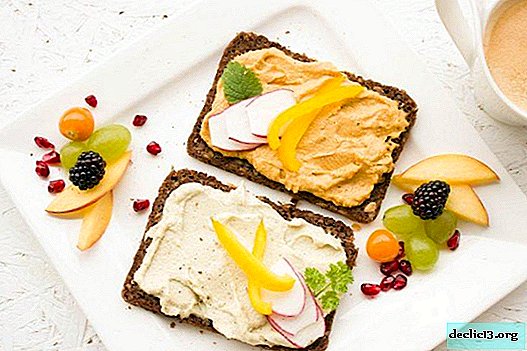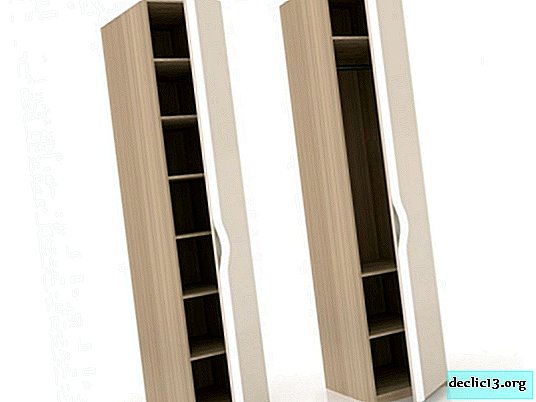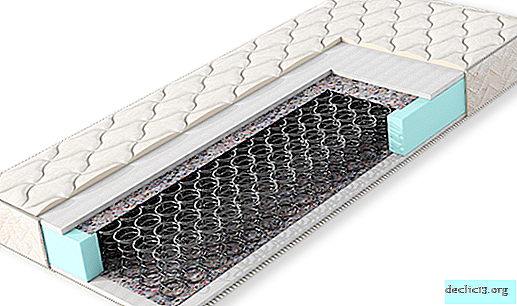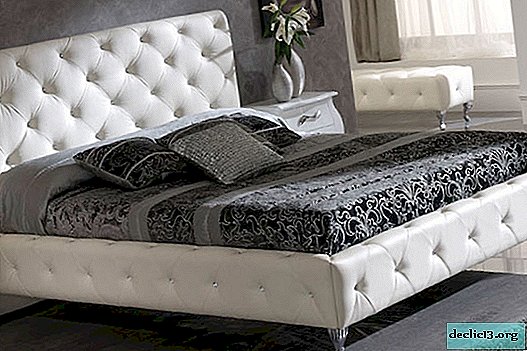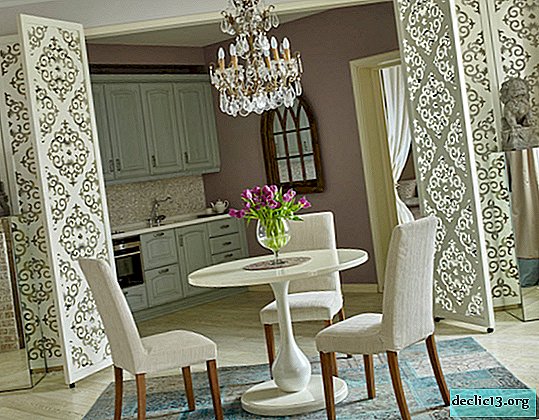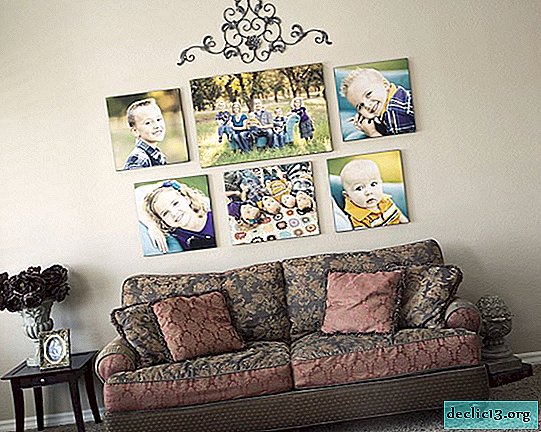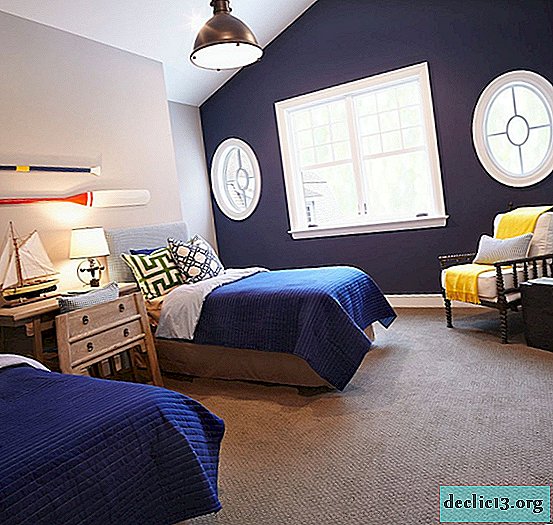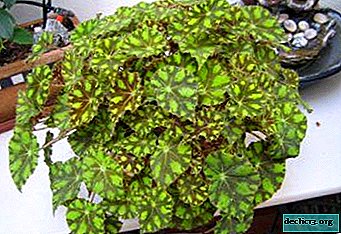Curtains in the living room: from A to Z
Content:
- Types of curtains for the living room
- The choice of material, shape, color and decor
- The choice of curtains for various types of interior
One of the main tasks in the design of the living room is to create a cozy and benign atmosphere for relaxation. Designers distinguish a number of techniques, thanks to which any of the interior styles, even distant from ideas about home comfort and arrangement, acquires a special harmony. You can fundamentally change the style vector due to the materials used in decorative decoration and additional accents. Natural textured wood, natural stone and textiles always fill the living room interior with a themed family atmosphere. However, some of the interior styles, by definition, can not be made using textured materials, as this violates the main plot and color scheme.
Properly selected textiles appear as an organic addition to such types of interior. Creating a well-designed living room interior requires special attention to natural light. Decorating the source of natural light - windows, gives the living room interior a special sophistication and completeness.
In the list of all kinds of tricks to revitalize the living room interior, the most relevant way is to use curtains. Such an element will complement any of the existing types of interior and bring a mandatory accent to the composition, distinguishing the living room from other rooms.
Classic curtains
Classical curtains of cold shades, without decorative additions are a universal type of window drapery for the living room
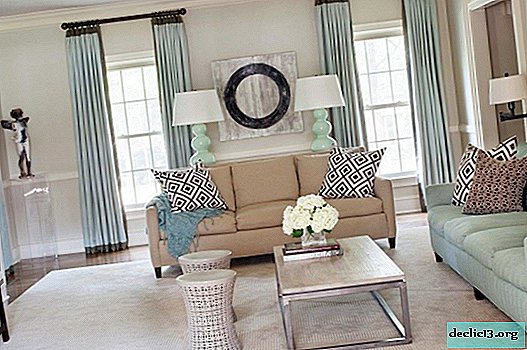
Emphasis on color
The color of the curtains should not match the color of the walls. You can focus on window draping using the difference in shades and a dynamic pattern with a repeating plot
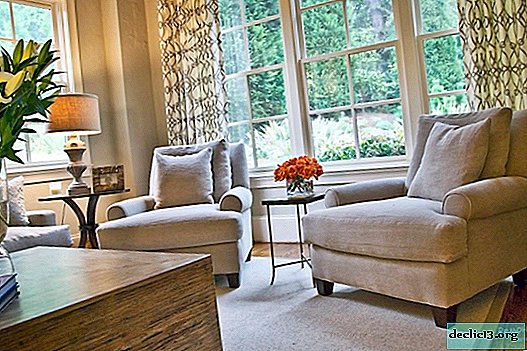
Colorful curtains
Curtains with a colorful pattern are complemented by small decor elements with a similar texture: pillows, plaid or bedspread, partial upholstery of furniture
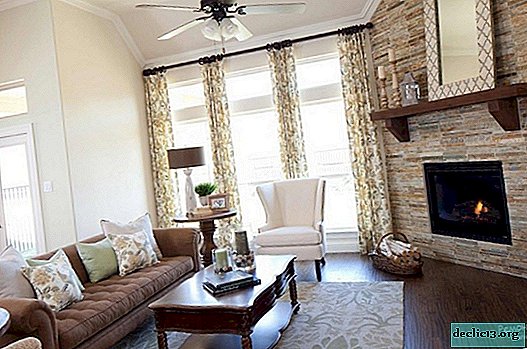
The combination of windows and curtains
Windows with dividing lines are complemented by curtains with small geometric patterns.
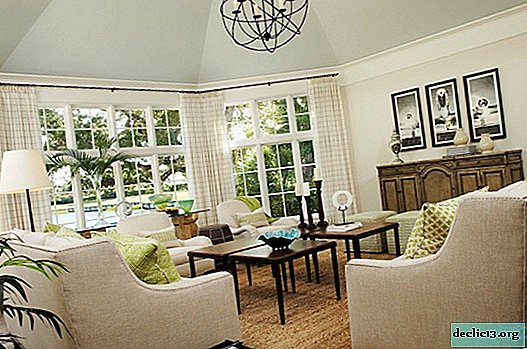
Color accents
Accents and contrasts are highlighted using a natural and geometric pattern, which has the most saturated color combined with the main color of the curtain fabric
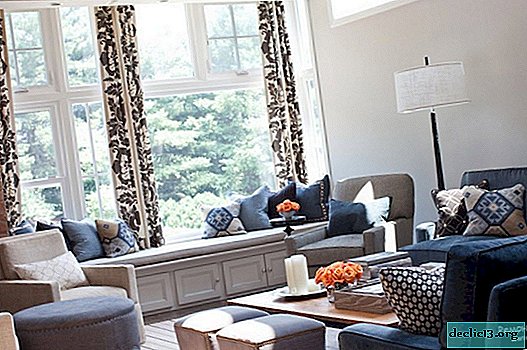
Curtain Mount
One of the most commonly used fixing techniques is an open ceiling cornice. The frame of multi-level ceilings is designed in such a way that a niche with a depth of 30 cm is formed near the window space. In this space there is a cornice and guides
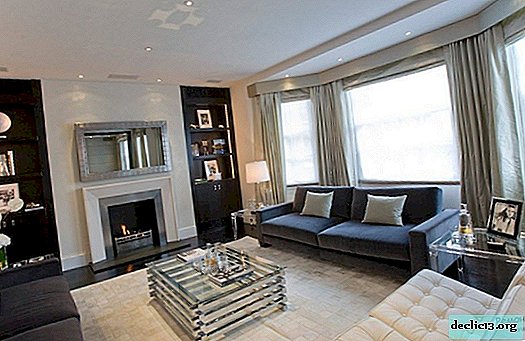
Curtains differ not only in color and variety of textiles. The first difference is stylistic. There are species that are far from the standard representation of the curtains, but are also representative of window curtains.
Classic curtains
Classical curtains include all types of window drapery made of soft textile and creating vertical waves. The name does not provide for the use of curtains of this kind exclusively in classic interior styles. “Classics” - defines first-priority, fundamental features, on the basis of which all subsequent types of curtains were created.
Satin classic curtains
Atlas focuses on the vertical lines characteristic of classic curtains
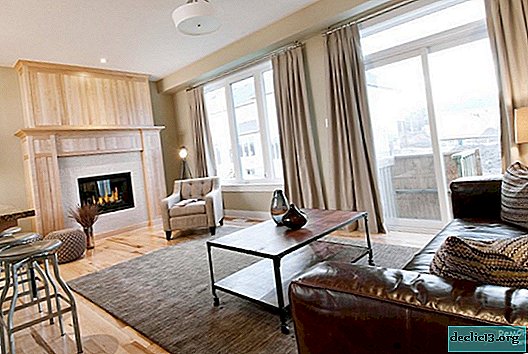
Two-color curtains
Vertical lines can be emphasized using contrasting interior colors.

Deep folds
Deep folds logically complement the dark cornice
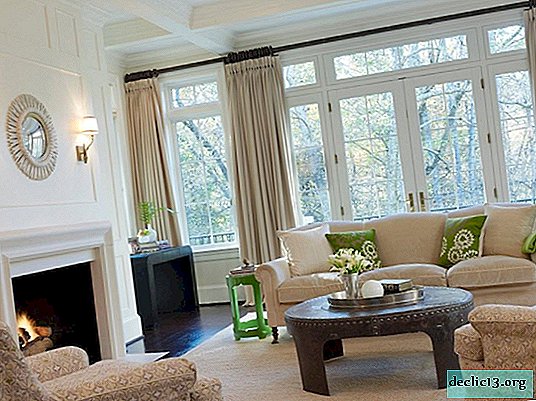
- looped. Using loops made of metal, wood, plastic or fabric and located on the basis of the curtain, the canvas is attached to the cornice;
- lace up. Fundamentally similar to the buttonhole, the method involves ties (shoelaces), with which the curtain is attached to the cornice;
- kuliskovym (typesetting). The drawstring located at the base of the curtain allows you to draw the canvas directly onto the baguette pin. (drawstring * - a narrow strip of hemmed fabric forming a through pocket for pulling the cord);
- lambric. A rim of curtains made of the same material and located in the upper part to mask the fastening;
- grommet. The fastening is a ring installed directly in the border of the base of the curtain. The whole row of rings is typed on the cornice.



 The choice of mounting method is determined by the stylistic predispositions of the interior, as well as convenience and style. The textile part of the classical curtains should form curly folds, focusing on the texture and quality of the fabric. Thanks to the drapery of the fabric, you can achieve various illusions that emphasize the style of the interior. The main characteristics of the canvas for classic curtains:
The choice of mounting method is determined by the stylistic predispositions of the interior, as well as convenience and style. The textile part of the classical curtains should form curly folds, focusing on the texture and quality of the fabric. Thanks to the drapery of the fabric, you can achieve various illusions that emphasize the style of the interior. The main characteristics of the canvas for classic curtains:
- tissue density. Classic curtains can be of any density, ranging from translucent materials, ending with a heavy coarse fabric;
- build factor. The parameter for calculating the width of the fabric, which correlates (multiplies) two indicators: the length of the cornice (1m) and the width of the fabric for it. If there are drawings on the canvas, then the coefficient should be no more than 1.5, for a more correct arrangement of decorative decoration. Plain curtains can have a build factor of 1.5 to 3;
- the presence of a lining. The lining makes the curtains heavy without letting in the daylight. This is a convenient way to combine two qualities of curtains: lightness, decorative texture and qualities of a screen;
- the presence of pickups. Grips allow you to assemble the curtain in the right place, complementing the overall decor.


Roller blinds (fabric roller blinds)
This type of curtain has a completely different kind of design. The fabric is wound on a shaft and fixed in the upper part of the window with the help of fixing corners. The shaft is supplemented with a small weight, for uniform distribution of fabric along the window opening. The mechanism of the roller blind is installed directly on the window frame, slope, walls or ceiling and provides two subspecies:
- a closed camouflage shaft using a box and has guides for tissue movement, which creates the appearance of a frame;
- open is a simple external shaft system.





The size of the roller blind should match the size of the window frame. In rare cases, the curtain is installed on the slopes, closing the entire window. For this installation method, it is necessary that the window sill does not have protruding parts that prevent the curtain from opening. In the form of a canvas, a translucent and non-transparent fabric is used. There are models in which two-layer fabrics are installed, rolling alternately. For mounting, two methods are used: drilling a window profile or wall cavity or gluing a cassette. The first method is more applicable for free-hanging curtains that are installed on slopes (walls or ceiling), the second is suitable for window profiles on which the functional part of the curtain is installed. Various manufacturers of roller blinds offer a variety of design additions that simplify the use of the mechanism. Additions can be both constructive and decorative. One of the latest technical additions allows you to open the top of the window, while leaving the bottom closed.
Jalousie
Blinds are highly functional, surpassing all existing types of curtains in their capabilities. The designs have a simple opening technology and a unique living room lighting control system. Blinds create a worthy competition for all types of window curtains, but until recently they were not used so widely. Office unpresentable appearance of blinds made of aluminum battens or fabric lamellas simplifies drapery of the window, making the overall look more presentable than cozy. New developments in the production of blinds provide a lot of options that are successfully applied in the interior of a living room.





Horizontal blinds are the simplest of the options that can be used in the interior of the living room only if the interior styling has this. In terms of practicality, horizontal blinds are the most convenient and functional. The design allows both to completely block the penetration of light rays and open the blades for full lighting.
The materials from which horizontal blinds are made do not require special care, a standard wet cleaning is sufficient. The hardware components of the blinds are classified as wear-resistant mechanisms that can last up to 20 years without replacement. Since all the starting materials for manufacturing are lightweight, horizontal blinds are installed on the window frame without burdening it. Another advantage is the personal qualities of the material: resistance to moisture, high temperatures and fading. Color models have not only standard shades, but also laminated surfaces that repeat wood and animal motifs. In the design of the living room, you can use the blinds as a functional element by installing them on the window frame. The outer part of the window can be draped with any type of translucent curtains to achieve a more decorative and full-fledged look of the interior.  Vertical blinds are a more suitable option when it comes to curtains in the living room. The design is a line of thin ribbons (lamellae of 80-120 cm) made of thick fabric and fixed to the cornice. Tapes are located with a slight overlap on each other. Each of the lamellas has a small weighting agent in the lower part, for uniform distribution of tissue along the entire length. The rope mechanism uses, with the help of a chain message, all ribbons, allowing them to be deployed in any position in relation to the window, starting from parallel, ending with perpendicular. Vertical gaps between the slats allow you to make the effect of diffused lighting in the living room.
Vertical blinds are a more suitable option when it comes to curtains in the living room. The design is a line of thin ribbons (lamellae of 80-120 cm) made of thick fabric and fixed to the cornice. Tapes are located with a slight overlap on each other. Each of the lamellas has a small weighting agent in the lower part, for uniform distribution of tissue along the entire length. The rope mechanism uses, with the help of a chain message, all ribbons, allowing them to be deployed in any position in relation to the window, starting from parallel, ending with perpendicular. Vertical gaps between the slats allow you to make the effect of diffused lighting in the living room.
Unlike horizontal blinds, vertical blinds are made of special types of dense fabric that requires care. Since each of the fabric lamellas is treated with a solution that gives it rigidity, a high level of moisture can deform the shape of the tape. Steam is used for cleaning. The stylistic possibilities of vertical blinds are much higher than horizontal. Firstly, the fabric base gives a logical look to the living room. Secondly, with the help of multi-level cornices it is possible to build lamellas in several rows, creating various "waves" due to the difference in levels and colors, similar to lambrequins. The decorative characteristics of the vertical blinds are close in capabilities to the Roman and Japanese curtains, which well and succinctly complement the simple and thoughtful interior styles.  Pleated, resembling horizontal blinds, have a completely different design. They are made of fabric assembled in a double-sided accordion, which allows compressing and stretching the canvas, like a spring. The fabric is fixed with a profile in the upper part of the window frame or on the window opening. The fabric base can be made of opaque or translucent materials, complemented by a small decorative pattern. Thanks to the corrugated canvas, it is possible to lift the curtain not only horizontally, but overestimating one edge above the other (at an angle), which is very convenient for windows of a non-standard shape. By the simplicity of care, the accordion pleats are comparable to ordinary curtains. The trading range offers a lot of varieties, according to the method of control, from manual fixation to remote. In the interior they can be used both independently and in addition with decorative curtains.
Pleated, resembling horizontal blinds, have a completely different design. They are made of fabric assembled in a double-sided accordion, which allows compressing and stretching the canvas, like a spring. The fabric is fixed with a profile in the upper part of the window frame or on the window opening. The fabric base can be made of opaque or translucent materials, complemented by a small decorative pattern. Thanks to the corrugated canvas, it is possible to lift the curtain not only horizontally, but overestimating one edge above the other (at an angle), which is very convenient for windows of a non-standard shape. By the simplicity of care, the accordion pleats are comparable to ordinary curtains. The trading range offers a lot of varieties, according to the method of control, from manual fixation to remote. In the interior they can be used both independently and in addition with decorative curtains. 
Roman curtains
Roman (or Romanesque) curtains are located on the window frame and have a peculiar design: an even cloth fabric, gathering in the direction from the bottom up, forming at the same time horizontal horizontal folds. The simple mechanism of the curtain consists of a cornice of fastening and a canvas penetrated by horizontal rods and weighted in the lower part. The movement of the curtains provides a rope mechanism that raises one division of the canvas after another, forming soft horizontal folds. There are two existing types of Roman curtains:
- the classic ones are made of smooth, even fabric; they are collected in identical folds overlapping one another;
- cascading are made of coarser fabric and have folds even when the curtains are fully open.
This kind of curtains does not belong to the traditional, if we are talking about complementing the interior of the living room. However, for the style of art deco, country, hi-tech or ethno, Roman curtains will be the best choice, complementing the overall style. To use this type of curtains in the living room, it is better to supplement the main part of the canvas with straight curtains, lambrequins or tulle.

Japanese curtains and noren
Traditional Japanese curtains are a typical representative of minimalism. Thin cloths with a weighting agent are fixed at the base of the wall, closing the window opening. A distinctive feature is the mechanism, which involves shifting the web to the side. Thanks to the translucent fabric, a screen effect is created that moves along the entire length of the wall, allowing you to adjust the lighting of the living room. For living rooms with large windows, several canvases of screen curtains are used, which are installed in different grooves of the ceiling cornice for mounting. Thanks to this system, the curtains can be pushed behind each other, like compartment doors.
The advantage lies not only in compactness, but also in the ability to completely curtain the window using several curtains at the same time. One strip of curtains has a minimum size of 0.8 m and a maximum of 4 m. Such a large range of sizes allows the use of Japanese curtains for very large window openings. The cornice designed for fixing and directional movement of the lamella (one strip of the curtain) can have from 2 to 5 channels.  Japanese curtains are often used as partitions. A thin fabric that separates one space from another takes up significantly less space than a wall or furniture that acts as a partition, and a translucent texture allows light to penetrate even into a corner of the room away from a natural light source.
Japanese curtains are often used as partitions. A thin fabric that separates one space from another takes up significantly less space than a wall or furniture that acts as a partition, and a translucent texture allows light to penetrate even into a corner of the room away from a natural light source.
Noren
A traditional type of curtains in Japan, which is used as a decorative element. The noren curtain has no practical value, it is a decorative and thematic fabric cloth with a long incision in the center. The length can be minimal, curtaining two-thirds of the window, or maximum - from the ceiling to the floor. Typically, noren was used for the exterior. Canvases were hung on the outside of the window or at the entrance as an advertising institution, informing visitors about the opening. By the end of the working day, the curtains were going to roll, which meant the closure of a store or other public institution. Today, such traditions are rarely used in store design, and only with the aim of focusing on the cultural and ethnic values of Japan.  The use of noren with a drawing of geishas, oriental temples, mythical characters is a good addition to the general idea of interior design in the style of Japan. However, such curtains cannot serve as full-fledged curtains and are used exclusively as a decor.
The use of noren with a drawing of geishas, oriental temples, mythical characters is a good addition to the general idea of interior design in the style of Japan. However, such curtains cannot serve as full-fledged curtains and are used exclusively as a decor.
French curtains
Traditional French curtains have a very sophisticated textural look and are a large canvas, collected in separate sections of the folds, falling to the bottom. Since drapery is assigned the main value, textured fabrics are selected, heavy with rich color. The collection of individual sections of the folds, as a rule, has symmetry. The entire canvas is divided into strips, between which an internal or external drawstring is made, for pulling the cord. The cord should be shorter than the canvas, in order to lift it, creating folds.  The fastening of the curtain is similar to the classical types - a standard curtain rod, onto which the curtain is drawn in a drawstring way or fastened into grooves, masking the base with a lambrequin. The curtains are decorated with tassels, grabs and fringe. There are two subspecies of French curtains:
The fastening of the curtain is similar to the classical types - a standard curtain rod, onto which the curtain is drawn in a drawstring way or fastened into grooves, masking the base with a lambrequin. The curtains are decorated with tassels, grabs and fringe. There are two subspecies of French curtains:
- lifting curtains have a mechanism that is interfaced with cords for drapery. With the help of cords, the canvas rises and falls to the desired height, allowing you to control the luminous flux;
- stationary curtains do not move in any direction, and do not rise up, because they are made of translucent fabrics and play the role of tulle, complemented by heavy textile at the edges.
French curtains with a lifting mechanism are often used for concert halls, because it has a very solemn appearance. With regard to the design of the living room - French curtains are the best option, but it is worth considering that excessive texture visually reduces the space.
Austrian curtains
Curtains belonging to the established traditions of Austria have similar features with the two types described above: French and Roman curtains. The textured canvas has lush uniform folds, like French curtains, and the assembly mechanism in the Roman style is a horizontal cascade lift. When the curtains are fully opened, the canvas is leveled and looks like a classic curtain with decorative additions at the bottom. With the help of the rope mechanism, the curtains are assembled, forming festoons - arched cascading folds. Austrian curtains have a length of 15-30 cm below the window sill and are attached using a ceiling or wall cornice. The residual length may be longer in order to assemble the lower part of the curtain into a fold in the form of a decorative addition.  Fabric for Austrian curtains can have any density. The established style features opaque lightweight fabrics. However, this option is difficult to apply to the living room, and is more suitable for a bedroom. Pearlescent translucent and transparent fabrics to a greater extent satisfy the requirements of the living room interior. Fabrics such as taffeta, rayon and cambric are distinguished by their mother-of-pearl shiny surface and are most suitable for sophisticated Austrian curtains. Dense fabrics do not require additions and are decorated with small details. Thin, transparent curtains should be complemented by a heavy lambrequin or thin classic curtains on both sides.
Fabric for Austrian curtains can have any density. The established style features opaque lightweight fabrics. However, this option is difficult to apply to the living room, and is more suitable for a bedroom. Pearlescent translucent and transparent fabrics to a greater extent satisfy the requirements of the living room interior. Fabrics such as taffeta, rayon and cambric are distinguished by their mother-of-pearl shiny surface and are most suitable for sophisticated Austrian curtains. Dense fabrics do not require additions and are decorated with small details. Thin, transparent curtains should be complemented by a heavy lambrequin or thin classic curtains on both sides.
The choice of material, color and additions
Curtain - the final element of decor in the interior of the living room. The fabric from which the curtain is made, color and decorative additions are selected individually for each of the interiors, based on the rules of the design of the living room and design recommendations when choosing curtains. Material, colors and fittings. The main material for the manufacture, as well as the functional and complementary accessories, are the defining quality of the curtains.










Materials
The choice of materials comes down to two parameters: the requirements of the interior and the type (style) of the curtains. Each of the interior styles involves the use of certain types of textiles, types of curtains characterize not only the structure, but also the fabric. Classic curtains are made of a low-textured soft fabric that creates vertical waves and folds. For Roman curtains, a translucent rough fabric with scars and relief is used. For Japanese curtains, thin transparent fabric without relief is suitable, and noren is made of light but dense fabric, most often of cotton. Soft, glossy fabrics are suitable for French curtains. Austrian curtains can be made of either coarse heavy fabric or transparent tulle with a glossy finish.
Roller blinds are always made of dense material, as well as vertical blinds and pleats. Horizontal blinds are made of metal and plastic. The choice of standard material for each type of curtain can be changed, giving preference to the requirement of interior style. Each of the existing types (with the exception of roller blinds, pleats and blinds) can be made of a different fabric, but it should be borne in mind that this can affect aesthetic features: creasing, light-transmitting abilities and stylistic content. Be sure to choose the material takes into account the practical side of the issue.
For rooms where there is a source of open fire (stove, fireplace, etc.), fabrics having low combustion characteristics are selected. In case the windows face the sunny side, a dense fabric that does not allow light to pass through is needed. The whole curtain, or the complementary part, can be made of dense fabric.  In the living room, stationary (not shifting to the side or up) curtains made of thick fabric are never used. To create a cozy atmosphere, natural lighting is necessary, therefore dense fabric is used in moderation and the curtains should always be able to open, letting in fresh sunlight into the living room.
In the living room, stationary (not shifting to the side or up) curtains made of thick fabric are never used. To create a cozy atmosphere, natural lighting is necessary, therefore dense fabric is used in moderation and the curtains should always be able to open, letting in fresh sunlight into the living room.  The choice of tissue density coefficient is affected by the size of the area. Transparent curtains always visually enlarge the living room by opening windows. Thick fabrics can only be used in large-sized living rooms. The same relationships are established between the area and texture of the fabric. Cramped, curly fabrics with many folds visually hide the free area, creating an oppressive atmosphere.
The choice of tissue density coefficient is affected by the size of the area. Transparent curtains always visually enlarge the living room by opening windows. Thick fabrics can only be used in large-sized living rooms. The same relationships are established between the area and texture of the fabric. Cramped, curly fabrics with many folds visually hide the free area, creating an oppressive atmosphere.
With the help of tissue folds, you can influence and adjust the shape of the area. The horizontal lines of the curtains help to “push apart” the walls and correctly submit a rectangular and trapezoidal, oblong area, where the windows are located on the smaller wall. Vertical lines of folds "raise" the flow and are well suited for living rooms with wall heights up to 3 m. Or compensate for the dimensions of a too massive and large chandelier in the center of the living room, if the chandelier is between the entrance and the window. 
Colors
Color is always determined by the interior, because it is difficult to establish categorical rules for choosing curtains in the living room. But practicing designers highlight a number of developments, following which they carry out the choice of color for curtains:
- To increase the space, the curtains are selected several tones lighter than the overall color of the walls;
- to determine the contrasts, the color of the curtains should be matched to the color of the furniture (if the furniture is located at least 2 m from the window);
- in the interior, with one or three colors or with a lot of textile, the curtains are selected to match the color of the largest textile element (carpet, sofa, bedspread).

- if the window needs to be masked, depriving it of any color shades, a translucent fabric of beige, cream, gray or sand colors is used. Combining the color of the curtains with the background color of the interior by logic: the cold shade is complemented by the warm;
- interiors involving the use of textiles as the main color element are emphasized by using one fabric (color and pattern) for curtains and small details: pillows, upholstery, etc.
- monochrome interiors are complemented by curtains not a few tones lighter or darker than the general, background. Two-color curtains with gradation of the main color scheme are well suited.
Color has a significant effect on the size of the living room. The basic rule of creating illusions, given the dependence of color and volume: dark colors reduce, light increase.


Using colors and shades ranging from violet red to sunny yellow will make the illusion of a larger and closer window. Cold palettes "expand" the space and fill it with "air." To visually enlarge the living room, use any of the cool shades and combinations of green, blue, white and gray.
Window size and shape
The shape of the curtains should emphasize the basic style of the interior, as well as complement the existing window shape. The most convenient for decoration is a vertically rectangular shape, such a window can be supplemented with any kind of curtains. Rectangular-horizontal look good with asymmetric curtains, offset to one side. Lowered windows need to be visually enlarged and raised, for this Japanese curtains or typical Japanese classic ones are suitable, made of a translucent material with a ceiling cornice and floor-length. To increase, you can use the lambrequin, which is located above the window opening.  Extra large panoramic windows are complemented by French, Austrian, Roman curtains or vertical blinds. Stained-glass windows are complemented by any of the types of curtains made of transparent lightweight fabrics. Arched window openings require maintaining the symmetry of the upper part, so the cornice should be attached to the ceiling, and the curtains should have a streamlined arched shape without unnecessary horizontal lines.
Extra large panoramic windows are complemented by French, Austrian, Roman curtains or vertical blinds. Stained-glass windows are complemented by any of the types of curtains made of transparent lightweight fabrics. Arched window openings require maintaining the symmetry of the upper part, so the cornice should be attached to the ceiling, and the curtains should have a streamlined arched shape without unnecessary horizontal lines.  As for the size, it is calculated in accordance with formulas, the initial indicators for which are the parameters of the window and window opening. First of all, the width and length of the window and the window opening are measured. For curtains that will be attached to the cornice, it is necessary to highlight the length of the area that the curtain should cover. Based on the size of the cornice, the amount of fabric is calculated:
As for the size, it is calculated in accordance with formulas, the initial indicators for which are the parameters of the window and window opening. First of all, the width and length of the window and the window opening are measured. For curtains that will be attached to the cornice, it is necessary to highlight the length of the area that the curtain should cover. Based on the size of the cornice, the amount of fabric is calculated:
| One curtain is long | |
|---|---|
| 300 cm | |
| 850 cm. | |
Standards
Calculations for blinds, roller blinds and pleats
Vertical blinds below the windowsill (not up to the floor)
Vertical floor blinds
Extras and decorDressing curtains complements and completes the overall appearance. It is important to consider that there are types of curtains that do not require decorative additions. For all others, you can use one or more varieties: Pickups Brushes, fringe
A selection of curtains for a variety of living room stylesThe determining factor for choosing curtains is the interior. Each of the existing interior styles has its own personal preferences and features in the decoration of window openings. The main stylistic directions are determined by fabrics, types of drapery, colors and decor. Greek antiquity, as the style of the interior, suggests using dark blackout curtains in cold shades, classic drapery with lambrequins and golden tassels. Well complements the style of metal (nickel silver and gold) pickups. The color of the curtains matches the color of the furniture. Watch the video: Interior Design Tips: Drapery Panels - 3 easy rules! (November 2024). |










 Used for the correct location of the curtains and the formation of folds. Thanks to the hooks, it is possible to free part of the window where the swinging part of the frame is located. The hooks can be metal, fabric, made in the form of beads hoops, magnets are also used. An unlimited number of different configurations and the use of non-standard things in the form of pickups are one of the best accessories for the interior.
Used for the correct location of the curtains and the formation of folds. Thanks to the hooks, it is possible to free part of the window where the swinging part of the frame is located. The hooks can be metal, fabric, made in the form of beads hoops, magnets are also used. An unlimited number of different configurations and the use of non-standard things in the form of pickups are one of the best accessories for the interior. They are used exclusively as additions, to emphasize and highlight a window in the interior. Brushes are often combined with pickups. For oriental interior styles, as well as for deeply classic designs of the living room, brushes and fringe are indispensable accessories. Decorative elements include a pattern on the fabric. Choosing a drawing is based on general stylistic requirements. In certain cases, it can be motley, in others, on the contrary, small and barely visible. There are interior styles that do not use textiles with patterns. If there is a need to choose a fabric with a pattern, it is important to consider the size of the room and the depth of the folds. A small pattern looks good on curtains with small folds, but you should not choose a fabric with very small details. All parts of the picture should be clearly visible from the opposite side of the room. Large patterns with a repeating plot are selected for curtains with deep folds that do not violate the shape of the picture. The curtain on which the composition is depicted - a large one-piece drawing, should be flat, without folds.
They are used exclusively as additions, to emphasize and highlight a window in the interior. Brushes are often combined with pickups. For oriental interior styles, as well as for deeply classic designs of the living room, brushes and fringe are indispensable accessories. Decorative elements include a pattern on the fabric. Choosing a drawing is based on general stylistic requirements. In certain cases, it can be motley, in others, on the contrary, small and barely visible. There are interior styles that do not use textiles with patterns. If there is a need to choose a fabric with a pattern, it is important to consider the size of the room and the depth of the folds. A small pattern looks good on curtains with small folds, but you should not choose a fabric with very small details. All parts of the picture should be clearly visible from the opposite side of the room. Large patterns with a repeating plot are selected for curtains with deep folds that do not violate the shape of the picture. The curtain on which the composition is depicted - a large one-piece drawing, should be flat, without folds. Roman antiquity proposes the use of classic types of curtains in two layers. The lower translucent layer is solid in the color of the walls with shallow waves. The upper one is darker in several tones, with fabric hooks and, possibly, fringe and tassels. Colors are exceptionally warm. You can use Roman curtains as the bottom layer.
Roman antiquity proposes the use of classic types of curtains in two layers. The lower translucent layer is solid in the color of the walls with shallow waves. The upper one is darker in several tones, with fabric hooks and, possibly, fringe and tassels. Colors are exceptionally warm. You can use Roman curtains as the bottom layer.  The Romanesque style is also performed in the classics and is complemented by pickups and brushes, however, it requires special attention to color combinations. Double-layer curtains with lambrequin, deep folds and contrasting color. The main color is chosen several tones brighter than the color of the walls, additional to the color of the furniture. You can use the third layer in the form of tulle, located directly at the window. It should have a shade close (but not repeating) to the color of the walls and shallow folds. Of course, with a detailed execution of the style, you can use all kinds of Roman curtains.
The Romanesque style is also performed in the classics and is complemented by pickups and brushes, however, it requires special attention to color combinations. Double-layer curtains with lambrequin, deep folds and contrasting color. The main color is chosen several tones brighter than the color of the walls, additional to the color of the furniture. You can use the third layer in the form of tulle, located directly at the window. It should have a shade close (but not repeating) to the color of the walls and shallow folds. Of course, with a detailed execution of the style, you can use all kinds of Roman curtains.  Gothic interior styles take away the emphasis from the windows, so the simplest types of curtains are used one shade darker than the walls, with small fabric pickups and a single-row lambrequin. Often used fabrics with a simple small pattern.
Gothic interior styles take away the emphasis from the windows, so the simplest types of curtains are used one shade darker than the walls, with small fabric pickups and a single-row lambrequin. Often used fabrics with a simple small pattern.  The Renaissance proposes to use all the possibilities of asymmetry, supplementing them with complex and heavy lambrequins. Opaque glossy fabrics with a fringe and without folds are supplemented by amazing forms of pelmets of the same color. According to the principle of developing the color features of the Renaissance, the color is chosen either one - corresponding to the dominant, or three - the most often used in the general interior.
The Renaissance proposes to use all the possibilities of asymmetry, supplementing them with complex and heavy lambrequins. Opaque glossy fabrics with a fringe and without folds are supplemented by amazing forms of pelmets of the same color. According to the principle of developing the color features of the Renaissance, the color is chosen either one - corresponding to the dominant, or three - the most often used in the general interior.  Baroque uses the most daring combinations of dark shades of red and gold with additional decorative brushes, ribbons, pickups. A luxury application requires the use of glossy, heavy fabrics in classic and French draperies.
Baroque uses the most daring combinations of dark shades of red and gold with additional decorative brushes, ribbons, pickups. A luxury application requires the use of glossy, heavy fabrics in classic and French draperies.  Rococo bears tenderness and lightness, so all fabrics are translucent, and the colors are "diluted with white." The construction scheme is classic with a small lambrequin. It is possible to use decorative patterns and embroidery on transparent fabrics. Fabric only pickups. Color matching from one gamut: blue classic silk curtains and white-blue tulle with small folds.
Rococo bears tenderness and lightness, so all fabrics are translucent, and the colors are "diluted with white." The construction scheme is classic with a small lambrequin. It is possible to use decorative patterns and embroidery on transparent fabrics. Fabric only pickups. Color matching from one gamut: blue classic silk curtains and white-blue tulle with small folds.  Classicism gives itself out in contrast to the lambrequin and tulle. Classic lambrequin drapery options and decorative elements in any of the convenient options. The main task is a combination of a dark lambrequin and transparent tulle, similar in color.
Classicism gives itself out in contrast to the lambrequin and tulle. Classic lambrequin drapery options and decorative elements in any of the convenient options. The main task is a combination of a dark lambrequin and transparent tulle, similar in color.  Empire style is made using combinations of beige and gold colors with dark shades of red, blue and brown. The drapery is classic, simple and dark lambrequin, light curtains with small folds and dark pick-ups made of fabric or metal.
Empire style is made using combinations of beige and gold colors with dark shades of red, blue and brown. The drapery is classic, simple and dark lambrequin, light curtains with small folds and dark pick-ups made of fabric or metal.  Art Nouveau is distinguished by its bizarre shapes and floral plot; these trends are fully used for the design of curtains. A variety of curtains, you can choose any of the existing, but fundamentally satisfying stylistics will be classic motifs: vertical folds without a lambrequin, dense fabric and cornice fastening. Colors can be combined, falling into the main gamut of the interior. The most commonly used cold shades of gray, beige, blue, as well as black and white contrasts. Perfectly complemented by a large pattern of floral motifs without accessories.
Art Nouveau is distinguished by its bizarre shapes and floral plot; these trends are fully used for the design of curtains. A variety of curtains, you can choose any of the existing, but fundamentally satisfying stylistics will be classic motifs: vertical folds without a lambrequin, dense fabric and cornice fastening. Colors can be combined, falling into the main gamut of the interior. The most commonly used cold shades of gray, beige, blue, as well as black and white contrasts. Perfectly complemented by a large pattern of floral motifs without accessories.  Constructivism requires competent work with space, without unnecessary details and texture. For the interior in this style, all types of blinds, fabric blinds, Japanese curtains and plain pleats are perfect. The color is determined several shades warmer than the color of the walls, it is possible to supplement with a thin pattern with a repeating plot.
Constructivism requires competent work with space, without unnecessary details and texture. For the interior in this style, all types of blinds, fabric blinds, Japanese curtains and plain pleats are perfect. The color is determined several shades warmer than the color of the walls, it is possible to supplement with a thin pattern with a repeating plot.  Minimalism the color of the curtains is always contrasting with the color of the walls. Curtains are made in Japanese or Roman style. Also well complement the interior shutters, shutters. Of the decorative additions, only small drawings on the translucent curtain fabric.
Minimalism the color of the curtains is always contrasting with the color of the walls. Curtains are made in Japanese or Roman style. Also well complement the interior shutters, shutters. Of the decorative additions, only small drawings on the translucent curtain fabric.  Pop art is either a form or a color. The interior will be complemented by French or Austrian curtains of plain color to match the walls (a tone lighter or darker). An alternative is the simplest curtains of classical drapery without a lambrequin, which are variegated from the general ensemble of color.
Pop art is either a form or a color. The interior will be complemented by French or Austrian curtains of plain color to match the walls (a tone lighter or darker). An alternative is the simplest curtains of classical drapery without a lambrequin, which are variegated from the general ensemble of color.  High-tech has a rather complicated logic of plot and composition construction, therefore it is impossible to single out a certain style of curtains. Curtains are a continuation of the walls and one of the main color accents. If one color prevails, then it is worth giving preference to curtains with an asymmetric shape, without a lambrequin and accessories five tones darker than the background. Rope curtains and blinds are well suited.
High-tech has a rather complicated logic of plot and composition construction, therefore it is impossible to single out a certain style of curtains. Curtains are a continuation of the walls and one of the main color accents. If one color prevails, then it is worth giving preference to curtains with an asymmetric shape, without a lambrequin and accessories five tones darker than the background. Rope curtains and blinds are well suited.  Kitsch is defined as creative tastelessness, so you can use any of the classic types of drapery, as well as French and Austrian curtains. Add-ons and accessories from props. Colors are plain and colorful. Sometimes you can use curtains color to color with walls.
Kitsch is defined as creative tastelessness, so you can use any of the classic types of drapery, as well as French and Austrian curtains. Add-ons and accessories from props. Colors are plain and colorful. Sometimes you can use curtains color to color with walls. 



